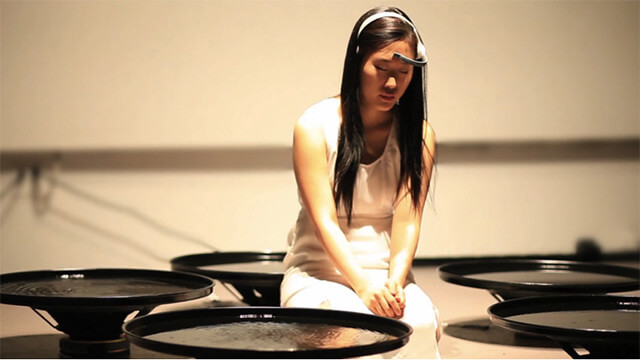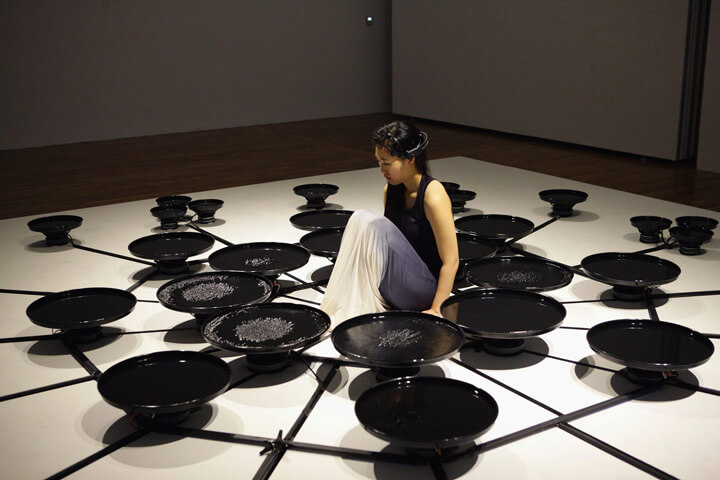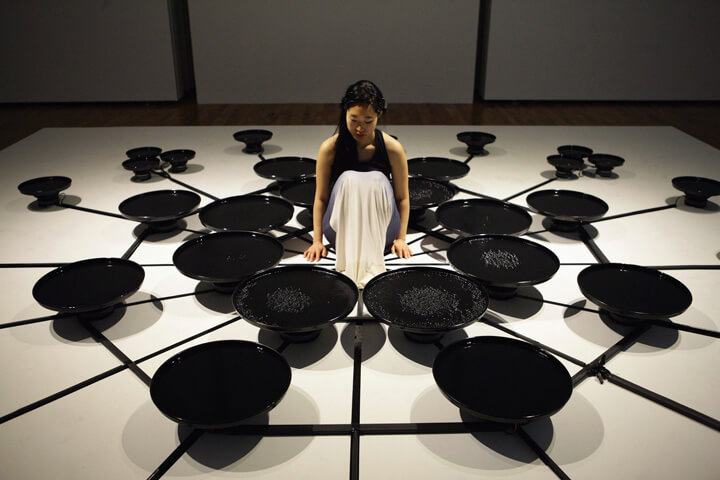Words by Lula Criado
The brain, which is the most complex and enigmatic organ in a vertebrate body, has the ability to send and receive signals over long distances. Neurons, synaptic connections and neurotransmitters drive cell-to-cell communication and control the body. But what if brain activity could be visualized by using brain-computer technology?
New York-based artist Lisa Park uses her brainwaves—Alpha, Beta, Delta, Gamma and Theta— to create her technology-driven performance Eunoia. She wears the brain-computer technology of NeuroSky EEG headset, monitors her brain activity and transposes it onto dishes of water.
The collected data of brain activity including “Attention” and “Meditation” values modulated the sound waves in real-time, making the water on top of the speakers vibrate. This water, which reflects Park’s feelings, thoughts and emotions, alternates between still and rippling.
Eunoia is a poetic experience that caught my attention because, on one hand, it helps us understand how the brain works and, maybe in the future it could be used to diagnosis brain illness. On the other hand, the viewer is metaphorically transported into Lisa Park’s invisible state of mind. You feel like a tourist visiting Lisa’s mind and seeing, literally, in a dish of water emotions such as sadness, hatred, anger, desire and happiness.
In your latest interactive project Eunoia II you combine emotional states with wearable devices such as NeuroSky EEG (Emotiv). How did you come up with the idea to combine technology with emotions?
I have always been interested in understanding myself, my emotion, and my subconscious. So in the past few years, I started experimenting with brainwave sensors as a vehicle for manifesting my inner states. One of the first interactive artworks that I created was done by using a heart-rate monitor. And since I have to be the subject of my work, I have been doing performances lately with my interactive installation.
In real-time, emotional values (data) were picked up by the Emotiv headset such as Frustration, Meditation, Boredom/Engagement and Excitement. The collected data of emotional values were transformed into sound waves.
For instance, the Frustration values corresponded to louder sound output. And the lower meditation values modulated the frequency of water vibration to slow down. By listening and seeing the different formations of ripples and water responses, it enabled me to contemplate on my own emotional status and concentrate on the inner self.
What was the most difficult part of Eunoia II’s development?
I think the most challenging but exciting part of making work is the process. It is like finding pieces of a puzzle and putting them together. It took me a while to come up with “Eunoia II” as a continuation of “Eunoia”.
But I knew that I wanted to use 48 speakers with aluminium plates in various sizes. I was inspired by the Dutch philosopher Spinoza’s analysis of “48 categories of the human emotions” classified in his book ‘Ethica’. And, the layout of the installation was inspired by the structure of Gankyil, the symbol of East Asian Buddhism. It represents universal energies: Yin, Yang, and Zhong. which means “balance”.
What do you expect from the collaboration between technology and wearable devices and art?
Technology is definitely becoming a big part of our lives. We depend on digital tools and devices too much. Especially with wearable technology, it’s becoming less invasive and more personalized than ever. I’ve already seen many artists and creatives using technology as a medium in their art practice. And, I am looking forward to seeing what will happen in decades.
If you had the choice of being born in any period throughout history, which period would you choose?
I don’t know. I like this moment being part of this history because I think it’s definitely an interesting period of time that we are living in right now.
When I was 11, it was my first time to have a desktop computer. And now, computers and cell phones have become smaller, lighter, and more accessible. Seeing and experiencing this transition of how we are now living in this technologically driven society, I wonder how will it be in 20 years. I am opposed to technology being too advanced, but I think that it is inevitable.
What is your chief enemy of creativity?
Thinking too much and not taking action.
You couldn’t live without…
My parents. They have influenced me a lot and my background has shaped who I am right now.








